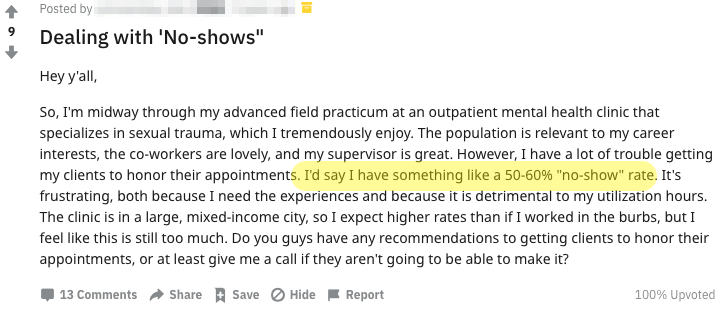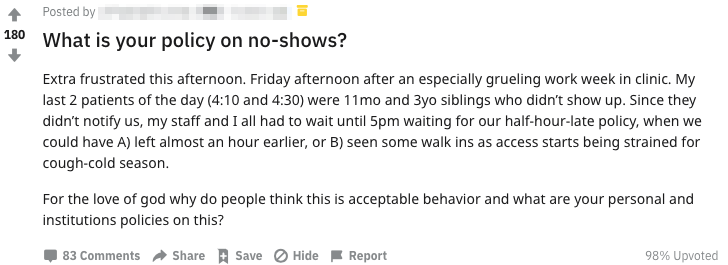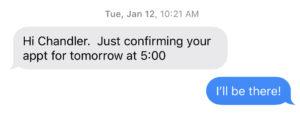For a practice owner who’s running a small or solo operation, there’s almost nothing more frustrating than a no-show for an appointment.
You have the time available, and people need your help. Then, frequently with no explanation, you’re sitting on your hands while valuable time goes unused.
The problem is rampant.
Can you imagine a schedule where over half of your appointments are no-shows? Or having slots on your schedule reserved for new patients, where they rarely show?
Check this out:
A “50-60% no-show rate”

New patient appointments where people “rarely show up.”

Crazy isn’t it? Exasperation is perhaps the most common response:
“For the love of god why do people think this is acceptable”

When things get bad, you just start assuming it’s a natural part of your work day:
“Schedule them for the last slot of the day, that way… I get off a little early.”

In particular, the no-show problem has less to do with what we do with the patient after the appointment is scheduled, and more to do with how we get them on our schedules to begin with.
It’s easy to think that your only option is to deal with the problem on the back end, when you haven’t stopped to examine the process that created it.
One group that can struggle with this mightily are practitioners who schedule their own appointments.
It’s understandable. They can’t stand the idea of someone slipping through the cracks, or not being treated well. And since they want a simple, efficient practice, they decide that it’s easier to just handle their own schedule.
If you’re one of those people, we need to talk.
(And if you’re NOT handling your own schedule, but you’re in the group that’s decided to use a receptionist to handle everything for you, y’all got issues too. I’ll get to you another time.)
So, tell me if this is you:
- You want to keep things as simple as possible for your practice, and you want to keep costs low.
- You think your schedule is pretty straightforward.
- You like being able to control the flow of your day, and know who is going where, and when.
- Because of all of this, you think it shouldn’t take too much effort to manage the schedule yourself.
So you do.
Patients call in, you talk to them about your practice, you get them scheduled.
At the end of each visit, you reschedule them if you can.
But then, there are the cancellations. The rescheduling. The last minute changes because they suddenly got sick or, my personal favorite, “traffic was just heavier than I thought.”
Add to that the ones who keep you on the phone for 4 days while they check to see if their sister-in-law is going to need to borrow their car, in which case they won’t be able to come in. Can you just hang on for one more minute while I find out?
God help me.
While it’s obvious how handling your own schedule can eat up a lot of time, it’s not as clear why that can lead to a problem with excessive no-shows. We’re going to get to why that is in a second, but first, the numbers.
Ask yourself: how many cancellations do you get a month? More importantly, how do you handle them?
Ready to streamline your practice?
Want to make your practice simpler, but you don't have the time to build a custom form? I've got you covered. Let me give you access to a library of pre-built New Patient Intake Forms made for Google and Google Workspace. All you have to do is select the one you want, load it into your account, and get going.
There are templates pre-made for massage therapists, physical therapists, mental health professionals, and chiropractors!
We keep your account 100% private at all times.
Do The Math
Let’s say your standard appointment costs $100.
If you have just 1 no-show a month, and you don’t get compensated for it, you’ve lost $100. Over the course of a year, that’s $1200 in missed appointments. Not chump change. If you miss two a month, you’ve lost $2400.
More commonly, practitioners will deal with at least 1 no-show per week. That can easily add up to over $5000 a year in lost revenue.
Unless you have a receptionist to police the issue (in which case you’re shelling out a lot of dough in another part of your practice), or you’re really good about holding a firm line with your cancellation policy, there’s a good chance that the amount you’re losing is substantial.
More than just the financial hit, who wants to waste valuable time sitting on your hands when you could be helping a patient in need?
But how does handling your own schedule lead to no-shows? Let’s look at that.
Reason #1: The No-Show Police Force
If you’re handling your own appointments, chances are you also have to be judge, jury, and executioner for your no-show policy.
This, in a word, sucks.
To make this work, you have to be completely clear, every single time, to every single patient, about what your policies are, what the penalty is, and how it’s enforced.
If a patient fails to show, you either have to tell the patient that they will be charged for the missed appointment, or you awkwardly let the incident go without repercussion.
With the first option, you give your patient a reason NOT to come in the next time, and with the second, you reinforce the fact that you’re less likely to hold them accountable the next time they decide to blow off an appointment.
Neither solution works. Beyond just the financial impact, what’s it costing you in frustration, or missed opportunities for patients or clients that really DO need to get in and see you?
Reason #2: A Policy Without Teeth
Even if you have a clear policy, you have to have a way to enforce it.
If you’re scheduling your own patients, and you want to actually be able to charge someone who doesn’t show up, you must have already collected their credit card information ahead of time, right?
If you haven’t done this, your patients have little incentive to honor any cancellation policy you might have. If they decide they don’t want to get hit with a cancellation fee, they can simply decide not to show up the next time.
But there’s a problem. The extra effort it takes to make sure you manually collect credit card information from someone, store it safely, and then make sure the patient is notified of your policies are additional drains on your time and energy.
Reason #3: Another Thing On Your To-Do List
I’ve been getting my haircut at the same place for years. The day before every appointment, I get a text message that my stylist sends me herself, asking me to confirm that I’ll be at the appointment.

It’s a great tactic to try and insure that her clients show up for their appointments. The problem is, she has to do this, every single day, for every appointment.
Handling things yourself feels attractive at the start. You have more control, and you’ve got eyes on all the pieces.
But your to-do list can expand rapidly.
- You have to make sure everyone understands your policies.
- If you want to have an effective cancellation policy, you have to collect credit card information yourself.
- If you want your patients to get notifications about their appointments, you have to somehow handle that, too.
The tasks you have to manage can just grow and grow, taking your once-simple, stress free practice into the realm of a logistical headache.
Accidental Discoveries
I’ve been in this place before.
I used to believe that having 1 or 2 no-shows a month was just part of the game. I told myself I’d get reimbursed for some, and the others I just had to eat as the cost of doing business.
I had no idea how wrong I was.
Back when I used a shared receptionist between myself and several other practitioners, I had no automatic email or text reminders sent to our patients about their appointments. While the receptionist did a great job, I still got at least 1 no-show a month under that setup, and frequently more.
While I wasn’t scheduling my own appointments, I had many of the same problems: no clear policies, no teeth to enforcement, and no automatic reminders.
I ended up solving these problems completely by accident.
Keeping tabs on how different healthcare practices run their businesses has always been a hobby of mine. I like learning how solid, referral-based practices make things seamless for their patients, and efficient for the staff.
Back when the first online scheduling services came out, the experience was pretty rough. There were lots of bugs, and you’d still have to have staff monitor the system constantly to make sure things ran with the flow that you expected in your practice.
So I kept watching and playing around, knowing that once the service got solid, I could save money I would have spent on a receptionist by having patients schedule themselves.
I finally made the plunge, and it was a big moment. This was back at a time when I knew of no other healthcare providers using a service like this.
I had no idea if it would turn out to be a triumph, or a mega failure.
I never looked back. The savings I got by not paying someone 30 or 40 hours a week to handle my scheduling was a no-brainer, and the service worked like a charm.
But then something happened that I never expected.
My no-shows were almost completely eliminated. Overnight, I went from having 1-2 no-shows a month, to about the same amount per year.
Why? Easy.
- My policy around no-shows, requiring 24 hr advance notice for cancellation (with exceptions for sickness or emergency), was clearly stated up front, and in follow-up reminders, every single time. No longer could a patient ever claim they weren’t made aware of the policy.
- Every patient was required to place a credit card on file to make an appointment. This gave my no-show policy some teeth. A patient could no longer sneak away without consequence. (Don’t get me wrong, I don’t spend time hunting down patients who don’t pay. It’s not a role, or image, I want, and in most cases it’s not worth the effort. Still, having patients know that it’s even possible for my office to charge their card goes a long way towards preventing the problem in the first place.)
- All patients got multiple email and text reminders of the appointment every single time. Patients aren’t annoyed by this. In fact, they regularly thank me for the follow ups to make sure they remember to get to the appointment on time.
The best part? Because of the reduction in no-shows, my online scheduling service paid for itself.
The standard fee for an online scheduler is anywhere from $20-$50 a month, and almost all of them include email and text reminders at no additional charge. This means if you only prevent one no-show a month, you’ve easily paid for the cost of the service.
All of the worries and logistical headaches that drive the no-show problem have solutions. You just have to be willing to put in a little up-front effort to establish a new, and easier, way of doing things.
So what’s holding you back? How do you handle your scheduling? And how do you handle your no-shows?
Tell me what you do, and why. I love learning how you solve the everyday challenges of your practice.
Ready to streamline your practice?
Want to make your practice simpler, but you don't have the time to build a custom form? I've got you covered. Let me give you access to a library of pre-built New Patient Intake Forms made for Google and Google Workspace. All you have to do is select the one you want, load it into your account, and get going.
There are templates pre-made for massage therapists, physical therapists, mental health professionals, and chiropractors!
We keep your account 100% private at all times.
